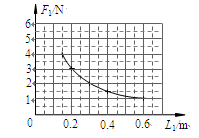问题
选择题
小华通过实验探究杠杆平衡时动力和动力臂的关系。实验过程中,保持阻力、阻力臂不变,在杠杆水平平衡时,测出每一组动力臂L1和动力F1的数据,并利用实验数据绘制了F1与L1的关系图像,如图所示。请根据图像推算,当L1为0.1m时,F1为 N。

答案
6。
题目分析:由图像可知动力与动力臂的关系符合反比例的特征,然后再通过个别数值去验证,发现3×0.2=2×0.3=1×0.6,所以F1L1=0.6Nm,故当L1=0.1m时,F1= =6N。
=6N。
